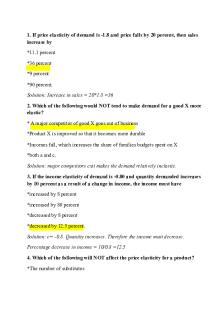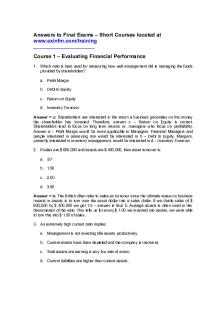Answers to 2014Q3 LMS PDF

| Title | Answers to 2014Q3 LMS |
|---|---|
| Author | Chelsea Wu |
| Course | Cost Management |
| Institution | University of Melbourne |
| Pages | 4 |
| File Size | 116.5 KB |
| File Type | |
| Total Downloads | 67 |
| Total Views | 177 |
Summary
N/A...
Description
Question 3
a) (i) Prepare a quantitative analysis that would help the company decide which watch models it should prioritise selling for the month of December, 2014. Determine the order of priority. (ii) How many units of each watch model should the company sell in December, 2014? (i)
LO would have the lowest priority as its contribution margin per unit is negative
Total machine hours required to fulfil SC and BV orders = 850 hours which is greater than the 700 machine hours available. Therefore Machine Hours is a constraint.
Total labour hours required to fulfil SC and BV orders = 900 hours which less than the 1,000 labour hours available. Therefore, labour hours is NOT a constraint.
Contribution margin per unit of constrained resource for SC: 120/0.3 = 400
Contribution margin per unit of constrained resource for BV: 90 / 0.5 = 180
Therefore it should prioritise selling SC, followed by BV and finally LO
(ii)
2,000 units of SC will be sold since this model is top priority.
Machine hours to produce 2,000 SC = 2,000 x 0.3hr = 600 hours; and leftover machine hours = 700 – 600 = 100 hour
Units of BV sold = (100 / 0.5 hours) = 200 units.
Units of LO: zero
b) What are two (2) additional factors that the company would also need to consider when deciding which models it should focus on selling in December 2014? Page 1 of 4
Need to consider if customers who ordered SC also order BV and LO. If the answer is yes, then how likely those who do not get their order filled for LO and BV also stop buying SC from you.
How important are the customers who ordered LO and BV? If they are important (e.g., due to expected large orders from them in the future), may decide prioritise the orders from these customers instead.
Intangible benefits of selling a less profitable product – e.g., selling LO could help the company enhance its reputation because this particular model is of high quality.
How does the decision to not produce a particular product affect employee morale
Would it be possible to shift additional idle labour resources (100 hours) to do the work that the machines (constrained capacity) were doing?
Page 2 of 4
c) It turns out that the supplier of its watch-making machines is willing to lease the company an additional machine to make watches for the whole month of December if needed. The leased machine is able to operate for 150 hours per month. The leased machine also has different capabilities than the company’s existing machine. As a result, the leased machine hours required to make each of the models are as follows: SC: 0.3 hours per watch LO: 0.4 hours per watch BV: 1.0 hours per watch Based on short-term quantitative factors alone, what is the lease payment that would cause the company to breakeven i.e., be indifferent between leasing and not leasing the machine for the month of December?
Leased machine can either be used to make SC or BV. Analysis 1: If make SC, then total units SC that the leased machine would be able to make = 150/0.3 hours = 500 units of SC. This 500 units of SC made by the leased machine would create 150 hours of spare capacity in the company’s machine. This would allow 150 hours / 0.5 = 300 units of BV to be made by the existing machine for which there is existing demand for. The relevant revenues from leasing the machine would be the contribution margin from selling the additional BV units since the demand for SC is totally fulfilled under both alternatives. The additional contribution margin from 300 units of BV is 300 x 90 = $27,000
Analysis 2: If make BV, then total units of BV that the leased machine would be able to make is 150 / 1 is 150 units of BV. Again the relevant revenues from leasing the asset would be the contribution margin from selling the additional BV units (150 units) which is now possible with the leased machine. This 150 units of BV would earn a total contribution margin of 150 x 90 = $13,500
Conclusion: break-even lease payment is 27,000 (i.e., the higher of the two)
Page 3 of 4
The following approach to answer 4 c is also acceptable.
Contribution margin per machine hour for new machine o SC: 120/0.3 = 400 >> same as old machine o BV: 90/1 = 90 >> lower than old machine o
Therefore, use new machine to make SC and old machine to make BV.
New machine makes SC: total units SC that the leased machine would be able to make = 150/0.3 hours = 500 units of SC. This 500 units of SC made by the leased machine would create 150 hours of spare capacity in the company’s machine. This would allow 150 hours / 0.5 = 300 units of BV to be made by the existing machine for which there is existing demand for. The relevant revenues from leasing the machine would be the contribution margin from selling the additional BV units since the demand for SC is totally fulfilled under both alternatives. The additional contribution margin from 300 units of BV is 300 x 90 = $27,000 Therefore the breakeven lease payment is 27,000
Page 4 of 4...
Similar Free PDFs

Answers to 2014Q3 LMS
- 4 Pages

How-To Reset UMT-LMS password
- 5 Pages

LMS 7Speaking - ingles
- 2 Pages

Learning Management System (LMS)
- 6 Pages

318 LMS - International Trade
- 2 Pages

LMS 7Speaking - ingles
- 1 Pages

LMS comerciales y gratuitas
- 8 Pages

Lab3 answers to questions
- 3 Pages

Answers to Case Studies
- 28 Pages

Answers to Moodle test
- 8 Pages

Answers to Test1 Econ141
- 4 Pages

Answers to Final Exams
- 42 Pages

Answers to the questions
- 27 Pages
Popular Institutions
- Tinajero National High School - Annex
- Politeknik Caltex Riau
- Yokohama City University
- SGT University
- University of Al-Qadisiyah
- Divine Word College of Vigan
- Techniek College Rotterdam
- Universidade de Santiago
- Universiti Teknologi MARA Cawangan Johor Kampus Pasir Gudang
- Poltekkes Kemenkes Yogyakarta
- Baguio City National High School
- Colegio san marcos
- preparatoria uno
- Centro de Bachillerato Tecnológico Industrial y de Servicios No. 107
- Dalian Maritime University
- Quang Trung Secondary School
- Colegio Tecnológico en Informática
- Corporación Regional de Educación Superior
- Grupo CEDVA
- Dar Al Uloom University
- Centro de Estudios Preuniversitarios de la Universidad Nacional de Ingeniería
- 上智大学
- Aakash International School, Nuna Majara
- San Felipe Neri Catholic School
- Kang Chiao International School - New Taipei City
- Misamis Occidental National High School
- Institución Educativa Escuela Normal Juan Ladrilleros
- Kolehiyo ng Pantukan
- Batanes State College
- Instituto Continental
- Sekolah Menengah Kejuruan Kesehatan Kaltara (Tarakan)
- Colegio de La Inmaculada Concepcion - Cebu


